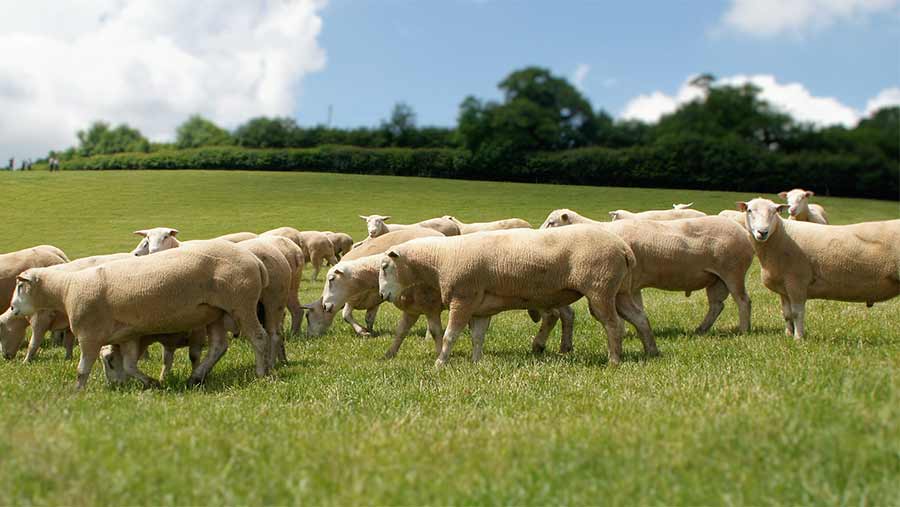New terminal sire available to improve lamb profitability

Lamb producers are being given the opportunity to try a new composite terminal sire breed.
Carcass data will be fed back to them to inform future breeding and management decisions, as part of a new supply chain initiative to improve profitability.
The breeder-processor initiative between genetics company Innovis and meat processor 2 Sisters Red Meat seeks to drive profit using New Zealand genetics that can produce fast-growing lambs with high-quality meat yield off grass.
See also: RamCompare project seeks sires
A total of 75 Focus Prime rams will be leased to farms supplying lamb to St Merryn, either for natural service or artificial insemination, as part of the link-up.
Supply chain benefits
- Producer: Progeny finish off grass in cost-effective and profitable systems
- Processor: More high-value cuts
- Retailer: Increased eating quality of meat
The Focus Prime ram combines two composite New Zealand breeds (Primera and Lamb Supreme) following two years of collaboration between Innovis and 2 Sisters Red Meat.
Negotiations are still under way on the cost of leasing rams, although this is likely to be calculated as a proportion of the value of the first draw of lambs for the first three years the sire is used (for example, 40% in 2017, 30% in 2018 and 30% in 2019) with the fourth year free.
Single-sire mated lambs from two farms in south-west Wales are already being individually recorded as part of the project to improve understanding of the carcass meat distribution the new breed offers.
This should address a “disjoint” in the lamb supply chain, said Peter Morris of 2 Sisters Red Meat Initiative.
Uniformity
Speaking at the Sheep Event at Malvern yesterday (27 July), Mr Morris said the sires were being brought in to genetically influence the distribution of high-value meat at the shoulder, loin and leg.
He underlined the importance of genetic development and industry cooperation to produce a uniform product and a consistent consumer eating experience and discussed the potential for a different payment system in the long term.
Mr Morris said: “We will continue to pay farmers on the grid. We are several steps away from a new grid system and at this stage it is about genetic decisions.”
But he stressed the project was not aimed at breeding lambs with huge legs as this gives a price point challenge. Instead, it was dr
Using Focus Prime rams
- Farms supplying St Merryn can lease rams for four years
- St Merryn takes the hit if the ram dies
- 75 available in all – expected to be used in batches of two or three
- Can be expected to service 100 ewes
- Following up with a sweeper after three weeks is recommended
- Focus Prime could be put to hill sheep to carry supply into late autumn
- Lease will be paid out of the first consignment of lambs each year for three years with the fourth year free
iving for less bone, less waste and moving meat into the shoulder and particularly the loin.
“Loin does not give a price point challenge,” he added. “We operate a standard lamb grid but for Innovis lambs there is currently the option of going on a bespoke grid with higher rewards and penalties.”
Farm trials
Carmarthenshire farmer Ben Anthony was involved in a study analysing progeny from 18 sires split across 13 groups of sheep sired naturally and five groups of AI-sired sheep.
He said outstanding lamb growth rates were recorded at Frowen Farm, Whitland, with the first of the singles out of his flock of Aberfield-cross, Tregaron Welsh-cross, Suffolk-cross and Texel-cross ewes.
See also:Fine-tuning ewe diets lifts lamb weights
He added: “We are intrigued to see which sires perform best at both farm and processing level. We have been extremely impressed with how quick the progeny test lambs are growing off grass.”
Scanning rates lifted to 195% from 150% in a typical year and all singles were away in 12 weeks, achieving daily liveweight gains of 450-500g and killing out at 52% with a 20kg carcass.
These lambs were finished off grass and Mr Anthony maximised gains from forage by growing chicory, clover and plantain on the farm.
Using AI enabled a progeny performance comparison with Focus Prime lambs from Neil Perkins’ Farm on Dinas Island.
